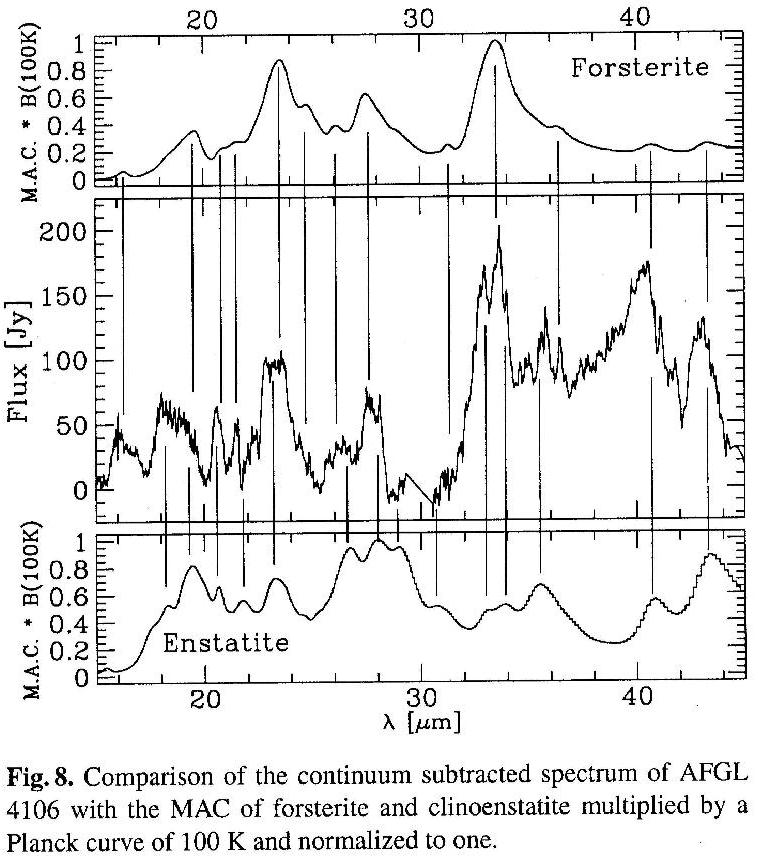
Astrophysical Background:
Before the Infrared Space Observatory
(ISO) satellite opened the mid- and far-infrared range for high-resolution
spectroscopy, it was generally assumed that cosmic dust silicates were
of amorphous structure.
Spectra gained by the Short
Wavelength Spectrometer (SWS) of the ISO have provided striking evidence
for the presence of crystalline silicates in comets, circumstellar envelopes
around young stars and, most of all, evolved stars and planetary nebulae.
Optical properties of silicates
Since optical properties of
astrophysically relevant crystalline silicates are lacking in the literature
we set up a spectroscopic programm to present optical properties of crystalline
silicates.
There are two approaches to characterize the extinction properties of these analogues:
The classical method is the determination of the optical constants of the bulk material and the use of these data as input for small-particle scattering calculations such as Mie calculations. This method is only suitable for materials which can be prepared as bulk material.
The other method is based on transmission measurements on small-particle systems. In this case, the importance of size, shape, and clustering effects is difficult to estimate as long as no measurements on isolated particles with a narrow size and shape distribution are performed.
Astrophysical relevant minerals
We focuse on minerals that are
expected to be high temperature condensates in stellar outflows and which
also occur in stellar accretion disks. This can be concluded from thermodynamic
model calculations. Furthermore, such minerals are found in chondritic
meteorites as CAI (calzium alumium inclusion) that are assumed to be original
condensates of the solar nebulae.
Hydrous silicates are also found
in meteorites and have to be regarded in exploring the thermal history
of the solar nebulae.
The most abundant dust forming
elements O, Si, Mg, Fe condense in a mixture of pyroxene and olivine. Infrared
spectra of crystalline silicate dust will be dominated by absorption and
emission features of these two mineral groups.
High temperature condensates:
garnet
(Mg, Fe, Ca)3Al2O4
perovskite
CaTiO3
melilithe, gehlenite, akermannite
(Ca, Na)2(Al, Mg)(Si, Al)2O7
feldspar (anorthite)
Ca[Al2Si2O8]
spinell
(Mg, Fe)(Al, Cr)2O4
Hydrous silicates:
serpentine
Mg6[(OH)8Si4O10]
talk
Mg3[(OH)2/Si4O10]
Most abundant minerals in cosmic
dust
clinopyroxene:
diopside, hedenbergite
Ca(Fe, Mg)(SiO3)2
orthopyroxene:
enstatite, hypersthene
(Mg,Fe)SiO3
olivine: (Colaboration project
with Prof.
W. Assmus, Kristall. und Materialentwicklungslabor, Universität Frankfurt
am Main)
forsterite, fayalite, olivine
(Mg, Fe)2SiO4
Measured transmission and reflectance spectra
as well as derived optical data that are published are collected in our
optical constants database.
We want to present:
Mass Absorption Coefficient (MAC) spectra in the wavenumber
range 2 ... 1 mm.
Reflectance spectra 200 nm ... 1 mm.
Optical constants (derived by KKR analysis or oscillator
fit from R) 200 nm ... 1 mm.
Laboratory study
For spectroscopy we use both natural and synthesized
single crystals. All samples are characterised by XRD and EDX analysis
to detect impurities and verify their chemical composition.
Mass Absorption Coefficients (MAC) are determined
from transmission measurements performed on powdered minerals. The bulk
samples are ground in an agate mill and sedimented to separate a charge
of particles smaller than 1 mikrometer. From this charge KBr and PE pellets
are prepared and transmission spectra obtained.
Reflectance spectra are obtained from polished
bulk samples. Optical anisotrop minerals (all non-cubic crystal systems)
are oriented by the X-ray Laue method and embedded in epoxyd resin. Reflectance
measurements is then performed using polarised light.
We endeavour to present data that cover the
wavelength range from 200 nm to 1000 Mikrometer (if sufficient big samples
are available).
Low temperature measurements
In astrophysical enviroments (molecular clouds
or the outer ranges of accretion disks) dust temperature is relatively
low (T < 100 K). Opacity of silicate particles at this temperature might
be different from that measured at room temperature. Therefore, measurements
at low temperatures are of heavy importance!
First study in this field has been done for
some amorphous and crystalline silicates as well as for important oxides.
Spectra of these samples which were cooled to about 10 K show a sharpening
and strengthening of the vibrational bands in the MIR range with decreasing
temperature. In the far infrared range a decrease in absorption with falling
temperature was found (Henning,
Mutschke 1997).
We plan to extend low temperature measurements
to a broader number of interesting silicates and oxides.
Comparison with astronomical
data
Measured data are compared to observed spectra
of astronomical dust sources.
The measured absorption spectra are multiplied
by a planck curve that relates to the assumed dust temperature.
Optical constants are used in model calculations.
A) Spectra of MAC of amorphous and crystalline
SiO2 multiplied with a planck function of 100 K.

B) The following plot is an example that data
of laboratory investigated crystalline silicates fit the observed spectra
of astrophysical objects in the IR wavelength range sufficiently
well.
(from
Jäger et al. 1998)

Analytical methods